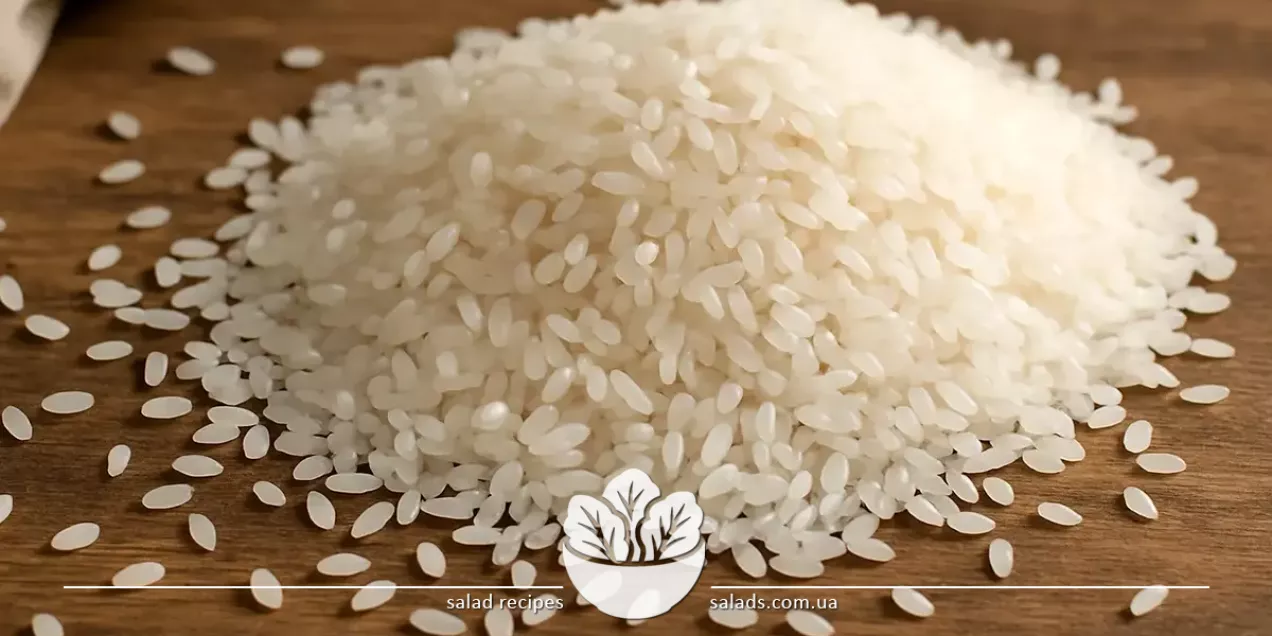
Rice

Rice is one of the oldest cultivated crops in the world and has gained popularity due to its versatility, nutrition, and adaptability to any cuisine. This groat has no pronounced flavor, so it easily combines with a wide variety of ingredients – meat, fish, vegetables, spices, and sauces. Rice serves as the base for pilaf, sushi, risotto, soups, salads, and even desserts. It cooks quickly, stores well, and provides the body with slow carbohydrates. Other types of rice can be found in the types of rice section.
Rice Salad Recipes
Nutritional Value and Benefits of Rice
Rice is a product that combines high energy value with easy digestibility, making it widely used in both everyday meals and dietary nutrition. 100 g of cooked rice contains about 110-130 kcal, with most of the calories coming from slow carbohydrates. Rice is gluten-free, has low allergenicity, and helps normalize gastrointestinal function. In addition to carbohydrates, rice contains a small amount of plant-based protein as well as potassium, phosphorus, magnesium, and B vitamins. During cooking, rice absorbs the aromas and flavors of other ingredients, making it an ideal base for many dishes. White rice is the most common type due to its soft texture and ability to cook easily. It is often used as a side dish or base for more complex culinary creations. A perfect example of a balanced and nutritious dish is the combination of rice with meat products. For instance, adding smoked ham to rice creates a rich, flavorful meal that requires little preparation. This can be a classic pilaf, a quick skillet mix, or a rice casserole with cheese and herbs. Such a duo offers a well-balanced blend of carbohydrates, proteins, and fats – the foundation of a complete meal.
Combining Rice with Fish and Seafood
Rice pairs excellently with fish, creating light, nutritious dishes rich in protein. This combination is used in many national cuisines: sushi and onigiri in Japan, paella in Spain, and various rice casseroles and salads across Europe. With its neutral flavor, rice complements both delicate white fish and fattier varieties, highlighting their texture and aroma without overpowering them. One of the most popular pairings is rice with canned fish. It’s convenient, quick, and very filling. Canned fish provides ready-to-eat protein, while rice supplies the meal’s energy base. This combination works well in salads, appetizers, pie fillings, or as a standalone dish with vegetables and herbs. A great example of such a pairing is canned mackerel. Its bold flavor and soft texture harmonize with both fluffy and sticky rice. Rice and mackerel salads, casseroles, lavash rolls, or even soups based on these two ingredients are excellent examples of affordable and nutritious meals that require no complex preparation techniques.
Rice Combined with Mushrooms
Mushrooms are among the most common ingredients paired with rice in vegetarian, Lenten, and classic dishes. This pairing offers a complete flavor profile and balanced texture, with rice serving as a nutritious base and mushrooms providing rich aroma, juiciness, and depth. This is especially evident in baked or pan-cooked meals, where both components absorb spices and oil well. Rice with mushrooms is often prepared as pilaf, risotto, casserole, or filling for pies and crepes. The dish can be enhanced with onions, carrots, cream, sour cream, or vegetable oil depending on the recipe. It’s one of the best options for a quick lunch or dinner as it doesn’t require expensive ingredients and allows for improvisation. The most common choice for such dishes is fresh champignons. They’re easy to cook, have a mild yet recognizable aroma, and maintain their shape even after heat treatment. This preserves the dish’s pleasant texture, and the pairing with rice becomes both nutritious and visually appealing. Just add a bit of herbs and spices – and a simple side dish turns into a complete main course.
Rice and Sauces: Creating a Flavor Palette
Because rice has a rather neutral taste, it’s perfect as a base for dishes with sauces. This quality makes rice a key element in Asian cuisines, particularly Chinese, Japanese, Korean, and Thai. Sauces enhance the dish with flavor, aroma, color, and a sense of completeness. Rice pairs especially well with spicy, sweet and sour, creamy, and soy-based sauces. In home cooking, the most versatile option is fried rice with vegetables, eggs, meat, or fish, topped with a favorite sauce. This kind of dish cooks quickly, is filling, and allows for easy improvisation. Sauces may be classic – based on tomatoes or cream – or include exotic ingredients like ginger, sesame oil, coconut milk, or miso paste. The most commonly used is soy sauce – as a primary or supplementary component. It enhances the flavor of rice, adds saltiness and umami notes, and pairs perfectly with vegetables, meat, and seafood. Thanks to its liquid consistency, the sauce spreads evenly across the dish, making it juicier and more aromatic. It’s a key element in many wok meals and rice-based salads.
Hearty Dishes with Rice and Poultry
Rice goes well with chicken and other types of poultry, forming filling, balanced, and easy-to-make meals. This combination is popular worldwide – from traditional pilaf and Asian fried rice with chicken to Mexican burritos. With the variety of rice types and cooking methods for chicken, such dishes can be tailored to any taste, calorie needs, or preparation time. Rice perfectly absorbs meat juices and spices, creating a deep and rich flavor profile. The most common option is pairing with sautéed or baked chicken fillet. It can be diced, sliced, or shredded for even distribution throughout the dish. Chicken cooks quickly, doesn’t weigh down the meal, and contains complete animal protein. The best option is chicken fillet – lean, tender, and versatile. It can be combined with any vegetables, herbs, cheese, mushrooms, sauces, or spices. When paired with rice, the fillet creates a complete meal that suits both daily menus and special occasions. It’s a foundational combination easily adapted to individual preferences.